
St. Raphael's Cathedral is a Catholic cathedral and a parish church in the Archdiocese of Dubuque located in Dubuque, Iowa. The parish is the oldest congregation of any Christian denomination in the state of Iowa. The cathedral church, rectory, former convent, and former parochial school building are contributing properties in the Cathedral Historic District on the National Register of Historic Places.

Saint Mary's Catholic Church is a former parish of the Archdiocese of Dubuque. The church is located in Dubuque, Iowa, United States, at the corner of 15th and White Streets. The church is recognizable by its steeple– one of the tallest in the area. The church property was added to the National Register of Historic Places as an historic district in 2015, and the various buildings were included as contributing properties in the Washington Residential Historic District later in the same year.

St Eunan's Cathedral, or the Cathedral of St Eunan and St Columba as it is also known, is a cathedral in the parish of Conwal and Leck, part of the Diocese of Raphoe. Built between the years of 1890 and 1900, the cathedral is found in Letterkenny, County Donegal in Ireland. There are two cathedrals in the county; an older cathedral of the same name is found in the town of Raphoe, and since the Reformation, has been used by the Church of Ireland.

Sacred Heart Cathedral, located in Davenport, Iowa, United States, is a Catholic cathedral and a parish church in the Diocese of Davenport. The cathedral is located on a bluff overlooking the Mississippi River to the east of Downtown Davenport. It is listed on the National Register of Historic Places as part of the Sacred Heart Roman Catholic Cathedral Complex. This designation includes the church building, rectory, and the former convent, which was torn down in 2012. The cathedral is adjacent to the Cork Hill Historic District, also on the National Register. Its location on Cork Hill, a section of the city settled by Irish immigrants.
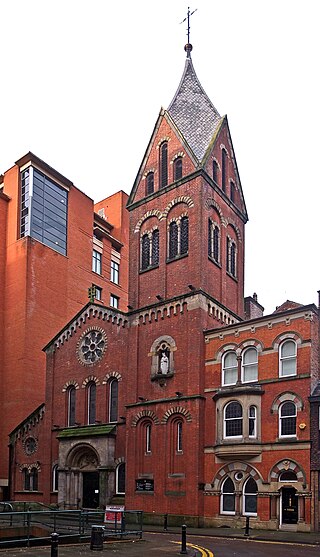
The Hidden Gem, officially St Mary's Catholic Church, is a church on Mulberry Street, Manchester, England. The parish dates back to 1794, with devotion to St Mary, Our Lady of the Assumption, and the present church, rebuilt in 1848, is a Grade II*-listed building which includes the Diocesan Shrine of Our Lady of Manchester.
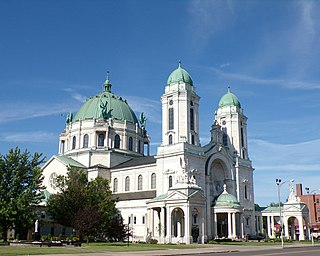
The Our Lady of Victory Basilica is a Catholic parish church and national shrine in Lackawanna, New York. Due to the multiple charities of founder Father Nelson Baker, the shrine is a popular pilgrimage and visitor destination in Lackawanna. It is part of the Diocese of Buffalo.

St. Mary's Catholic Church, also known as St. Mary of the Visitation Church, is a parish church of the Diocese of Davenport which is located in Iowa City, Iowa, United States. The church building and rectory were listed together on the National Register of Historic Places in 1980. They were both included as contributing properties in the Jefferson Street Historic District in 2004. The parish's first rectory, which is now a private home, is also listed on the National Register as St. Mary's Rectory. It is located a few blocks to the east of the present church location at 610 E. Jefferson St.
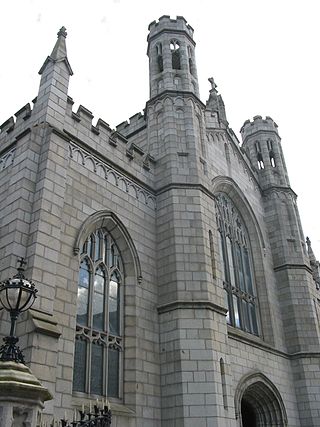
The Cathedral of Saint Patrick and Saint Colman or Newry Cathedral is a Roman Catholic cathedral located in Newry, Northern Ireland. It acts as the seat of the Bishop of Dromore, and the Mother church of the Roman Catholic Diocese of Dromore. Prior to the COVID-19 pandemic, over 200,000 people visited the cathedral each year. The cathedral sits on Newry's Main Street and is a Grade A listed building.

The Church of All Saints is a parish of the Catholic Church in the Diocese of Davenport. The church is located in Keokuk, Iowa, United States. The church building is listed on the National Register of Historic Places as St. Peter Church, the name of the congregation that built it.

Saints Peter and Paul Catholic Church is a former parish church of the Diocese of Davenport. The church is located in rural Solon, Iowa, United States. The property is on a gravel road east of Iowa Highway 1 between Solon and Mount Vernon in rural Johnson County. It was listed on the National Register of Historic Places in 1999.

St. Mary of the Visitation Catholic Church is a parish of the Diocese of Davenport. The church building is located on the corner of 4th and Court Streets in downtown Ottumwa, Iowa, United States. It is part of the Central Park area, which is the civic center of the community. It includes: the Wapello County Courthouse, the Ottumwa Public Library, and the Ottumwa City Hall. The church is eligible for the National Register of Historic Places, but it has not been listed.

St. Patrick's Catholic Church is a parish of the Diocese of Davenport. The church is located in rural Monroe County, Iowa, United States, on U.S. Highway 34, west of Albia, Iowa. It is located in an unincorporated area known as Georgetown and is listed on the National Register of Historic Places.

St. Mary's Catholic Church is a parish church of the Diocese of Davenport. The church is located at the corner of St. Mary's and Washburn Streets in the town of Riverside, Iowa, United States. The entire parish complex forms an historic district listed on the National Register of Historic Places as St. Mary's Parish Church Buildings. The designation includes the church building, rectory, the former church, and former school building. The former convent, which was included in the historical designation, is no longer in existence.

St. Boniface Catholic Church is a parish of the Diocese of Des Moines. The church is located in Westphalia, Iowa, United States, and the parish plant is listed on the National Register of Historic Places as Saint Boniface Catholic Church District. At the time of its nomination the district consisted of 16 resources, including six contributing buildings, one contributing structure, two contributing sites, one contributing object, six noncontributing buildings, and one noncontributing object.
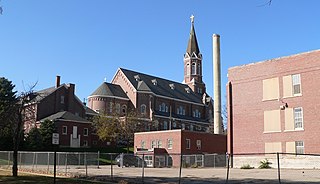
St. Boniface Catholic Church is a parish of the Diocese of Sioux City. The church is located in a residential area west of downtown Sioux City, Iowa, United States. The parish buildings form a nationally recognized historic district that was listed on the National Register of Historic Places in 1998 as St. Boniface Historic District. At the time of its nomination it contained three resources, all of them contributing buildings.

Saint Irenaeus Church is a former parish of the Diocese of Davenport. The church was founded in the town of Lyons, which now the north side of Clinton, Iowa, United States. It has been listed on the National Register of Historic Places since 2010.
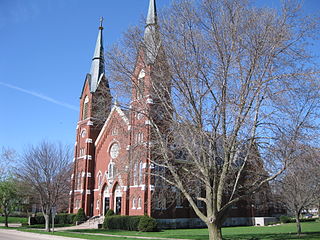
St. Boniface Church is a former parish church of the Diocese of Davenport. The church was founded in the town of Lyons, which is now the north side of Clinton, Iowa, United States. The church building is now a museum named The Catholic Historical Center at St. Boniface, with exhibits about the history of the Clinton area Catholic community, and an archive of local Catholic church artifacts and records. The church was listed on the National Register of Historic Places in 2012.

St. Patrick's Catholic Church is a historic Catholic church located in Perry, Iowa, United States. The parish is part of the Diocese of Des Moines. The church building, which is built of stone in the Gothic Revival style, and the rectory were listed on the National Register of Historic Places in 2011.

The Church of St. John the Baptist is a historic church building located in Burlington, Iowa, United States. Together with St. Paul's Church in Burlington and St Mary's Church in West Burlington it forms Divine Mercy parish, which is a part of the Diocese of Davenport. The parish maintains the former parish church buildings as worship sites. St. John's was listed on the National Register of Historic Places in 1982.

St. Paul's Catholic Church is a historic church building located in Burlington, Iowa, United States. Together with the Church of St. John the Baptist in Burlington and St Mary's Church in West Burlington it forms Divine Mercy parish, which is a part of the Diocese of Davenport. The parish maintains the former parish church buildings as worship sites. St. Paul's Church and the rectory are contributing properties in the Heritage Hill Historic District listed on the National Register of Historic Places. St. Paul's School was also a contributing property in the historic district, but it has subsequently been torn down.
























